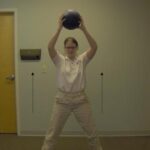Living with osteoarthritic (OA) knee pain can limit your mobility and keep you from doing many of the things you enjoy. Lifestyle choices are often the only things that need to be addressed for treating and managing OA knee pain.
Exercise can help stretch and strengthen the knees, hips and leg muscles, improve balance and promote good posture. Knee pain can limit exercise and other simple activities which leads to accumulation of excess weight. Many of us, as we age, lose our sense of balance. A large part of loss of balance can be due to poor muscle tone. Additional strain on the knees, caused by excess body weight, adds to knee pain and the progression of osteoarthritis. Weight loss helps lessen the stress on knee joints which reduces pain, increases mobility, helps you stand and walk with greater confidence, which improves balance through muscle tone. Go slow and break the cycle by easing into an exercise program that you enjoy. More people stick with walking than any other exercise.
One of the dangers connected to loss of balance is falling and breaking a major bone, like the hip. Research over many decades has indicated that drinking sodas, cola in particular, can lead to loss of bone mass and contribute to osteoporosis. Soft drinks, particularly colas, affect bone density in several ways. People who drink sodas often replace beverages high in calcium and vitamin D with their favorite soda. The caffeine in sodas, coffee, tea, and other drinks that contain caffeine, have been linked to a higher risk of osteoporosis. Coffee is the number one drug choice in the world. My parents drank multiple cups of coffee per day. My mother had advanced osteoporosis and died after fracturing her hip. My father had lost many inches in height and was collapsing forward, Dowagers Hump Syndrome, when he died in his early sixties.
One ingredient found in colas is phosphoric acid. Higher than normal amounts of phosphoric acid in the body causes a blood acid imbalance. The body’s natural defense is to neutralize acid with calcium. If the diet doesn’t contain enough calcium, calcium is taken from the bones. Milk contains phosphoric acid but it’s balanced out with calcium and vitamin D. Sodas contain large amounts of sugar. Sugar and high fructose corn syrup (HFCS) are acid based.
Osteoporosis thins the bones, leaving them at risk of fracture. More than half of all Americans, especially post-menopausal women, have an increased risk of developing osteoporosis according to the National Osteoporosis Foundation.
A research project at Tufts University, that included more than 2,500 people with an average age of about 60, found that cola consumption by women was associated with lower bone mineral density at three hip sites. The women reported drinking an average of five carbonated drinks a week, four of which were colas.
An important way to prevent osteoporosis is to exercise. One half hour a day for adults and one hour a day for children is the minimum standard recommendation. Walking at least a half mile a day and doing some form of weight bearing exercise can help improve bone mass density.



